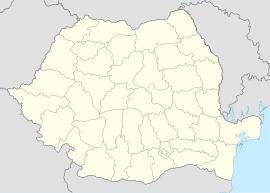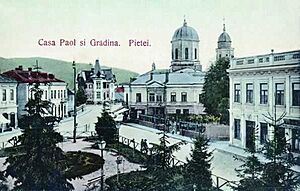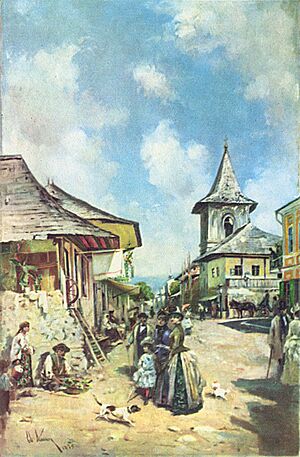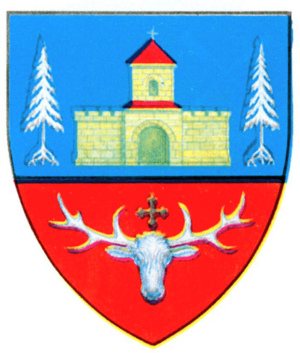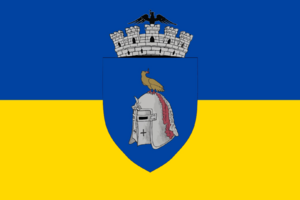Câmpulung facts for kids
Quick facts for kids
Câmpulung
|
||
|---|---|---|
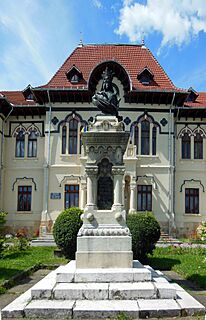
The bust of Negru Vodă
|
||
|
||
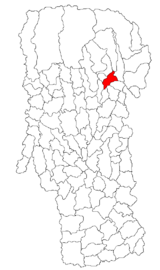
Location in Argeș County
|
||
| Country | ||
| County | Argeș | |
| Area | 35.59 km2 (13.74 sq mi) | |
| Elevation | 600 m (2,000 ft) | |
| Highest elevation | 780 m (2,560 ft) | |
| Lowest elevation | 580 m (1,900 ft) | |
| Population
(2011)
|
Lua error in Module:Wd at line 1,575: attempt to index field 'wikibase' (a nil value). | |
| Time zone | EET/EEST (UTC+2/+3) | |
| Postal code |
115100
|
|
| Area code | (+40) 02 48 | |
Câmpulung (also spelled Cîmpulung) is a city in Argeș County, Muntenia, Romania. It sits among the hills of the Southern Carpathians. The city is at the start of a long, wooded valley, with the Târgului River flowing through it. This river is a branch of the Argeș River.
Câmpulung is known for its clean air and beautiful scenery, making it a popular place to visit in the summer. The city has more than twenty churches, plus a monastery and a cathedral. Both of these religious buildings are said to have been started in the 13th century by Radu Negru. He was a legendary first Prince of Wallachia. The city is also quite old, with many buildings from the 18th and 19th centuries still standing. This makes Câmpulung feel like a "time capsule" from the past.
Contents
What's in a Name?
The name "Câmpulung" means "Long Field" in Romanian. In Latin, it was called "Longus-Campus." Sometimes, people also call it "Câmpulung Muscel" or "Câmpu−lung". In Old Romanian, which came from Middle Bulgarian, it was known as Dlăgopole, meaning the same thing: "a long field."
A Look at History
Near Câmpulung, you can find the remains of an old Roman fort called Jidava (or Jidova) Roman fort. This fort was built around 190–211 AD. It was part of the Roman Empire's border, known as the Limes Transalutanus. Right next to it, there are also signs of an old Roman town. This area is now called Grădiștea, which means "place of a fortress" in Romanian.
Câmpulung was also important because it was only 37 kilometers away from the Bran Pass. This pass was a key route for both traders and armies moving through the region.
The Middle Ages
Câmpulung was the very first capital of Wallachia, which was a feudal state. This suggests the city might have been founded in the 13th century. It remained the capital until the 14th century, when Curtea de Argeș took its place. The city had a lot of trade with Transylvania, especially through the Rucăr–Bran Pass, which is 24 kilometers to the north. There was also trade with the south, connected by a railway to Ploiești.
Câmpulung was one of the first towns to develop in Wallachia. German colonists from Transylvania helped it grow by bringing their city culture. The oldest written proof of the town's existence is from the year 1300. It's an epitaph (a message on a tombstone) found in the Câmpulung church. The message is about Laurencius de Longo Campo, who was likely in charge of the colonization process.
The oldest known written document in Old Romanian was found in 1521. It's called Neacșu's letter. This letter was sent to warn the city of Brasov about an upcoming attack by the Ottoman Empire. The letter also calls Câmpulung by its Old Romanian name, Dlăgopole, which means "a long field."
Early Modern Times
When the printing press became popular in Europe, Matei Basarab brought one to Câmpulung in 1635. Here, Orthodox books were printed and sent across the Balkan region for Orthodox people. However, this didn't last long. By 1650, there were no more records of books being printed there.
During the rule of Șerban Cantacuzino (1678–1688), there was pressure to change the Catholic judges in Câmpulung to Eastern Orthodox faith.
At first, the Romanian people in the town didn't have the same rights as the German colonists. But by the 15th century, the two groups had started to mix. This is shown by new Romanian churches built near Catholic areas. Also, some of the elected leaders were Romanians. Another group in the town were the Bogomil Bulgarians. They lived in the Șchei neighborhood. Șchei is an old Romanian word for Slavic people.
Modern Times
From the Middle Ages until 1822, Câmpulung had its own special autonomy, meaning it governed itself. This special status was taken away in 1822.
At the end of the 19th century, Câmpulung had about 11,244 people. Its main streets were called Negru Vodă, Râului, Matei Basarab, and Gruiului. These streets ran next to the city center and were paved with cobblestones. Some even had trees planted along them. There were three main squares: Sfântul Ilie, Scheiul, and a Județelor. Sfântul Ilie square was the most important. Next to the Sfântul Ilie church, there was a weekly market and a large yearly fair held between July 17 and 28.
In 1950, Muscel County was removed, and Câmpulung became a district town. It was the main town of the Muscel raion (a type of district) in the Argeș Region. In 1968, during a change in how the country was organized, the city lost its role as a regional center. It then became a city within Argeș County. Later, in 1994, Câmpulung was officially declared a municipality.
Population Over Time
| Historical population | ||
|---|---|---|
| Year | Pop. | ±% |
| 1859 | 8,283 | — |
| 1900 | 13,033 | +57.3% |
| 1912 | 16,090 | +23.5% |
| 1930 | 13,868 | −13.8% |
| 1948 | 18,174 | +31.0% |
| 1956 | 18,880 | +3.9% |
| 1966 | 24,877 | +31.8% |
| 1977 | 31,533 | +26.8% |
| 1992 | 44,125 | +39.9% |
| 2002 | 38,285 | −13.2% |
| 2011 | 31,767 | −17.0% |
| 2021 | 27,574 | −13.2% |
| Source: Census data | ||
Famous People from Câmpulung
Many notable people were born or lived in Câmpulung, including:
- Theodor Aman
- Constantin D. Aricescu
- Gheorghe Arsenescu
- Ion Barbu
- George Demetrescu Mirea
- Dora Gad
- Nicolae Golescu
- Ștefan Golescu
- Radu Gyr
- Ion Jinga
- Petre Libardi
- Gabriel Moiceanu
- Tudor Mușatescu
- D. Nanu
- Ion Negulici
- George Oprescu
- Constantin Ion Parhon
- Pârvu Mutu
- Dan Simonescu
- Mihail Vlădescu
See also
 In Spanish: Câmpulung para niños
In Spanish: Câmpulung para niños



